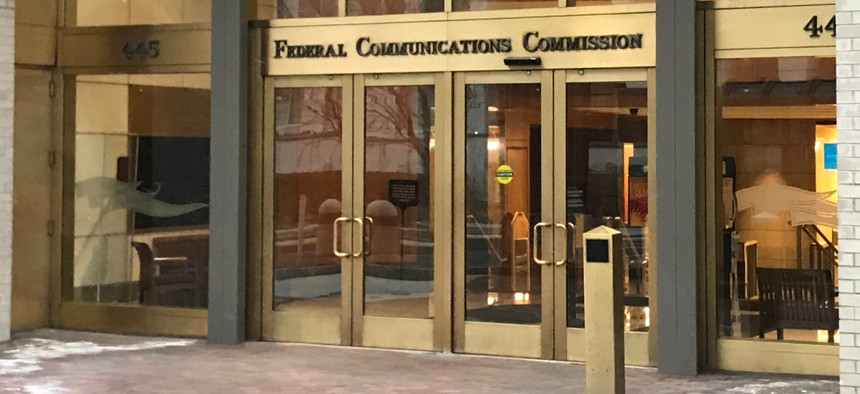Lawmakers Pressure FCC to Move Forward With Unfunded Supply Chain Security Order

DCStockPhotography/Shutterstock
A list of covered items that would be barred from receipt of federal subsidies is due in March and will draw from a variety of other federal efforts.
The chair and ranking member of the House Energy and Commerce Committee are assuring the head of the Federal Communications Commission that between $1-2 billion dollars is forthcoming and asked that the commission implement parts of a bill to reimburse smaller telecommunications providers for the cost of removing untrusted equipment from their systems.
The FCC is required to establish the reimbursement program under the Secure and Trusted Communications Network Act, which became law in March. The commission had proposed banning recipients of the Universal Service Fund—a public pool of money administered by the FCC to incentivize broadband buildouts in areas with low investment returns—from obtaining equipment from untrusted suppliers, including the Chinese firms Huawei and ZTE.
But while the bill suggested that at least $1 billion should be put toward reimbursing smaller providers for replacing the equipment, Congress never appropriated the money. The FCC has asked for double the amount suggested in the bill, noting that information they collected from providers shows it would take at least $1.6 billion to rip and replace the untrusted equipment and that additional costs are likely hidden.
The commission is set to vote Dec. 10 on a final order it proposed on the issue Nov. 19. The order details the reimbursement program but makes it all conditional on Congress appropriating the money.
In the meantime, the bill’s sponsors say the FCC should assure providers they will be reimbursed if they take action now, before the funding is secured, and set them up to do so by publishing a list of acceptable replacement equipment.
“While it has not yet been funded, the bipartisan committee leaders say there is every expectation it will be, and the FCC should begin immediately to initiate certain implementation steps,” reads a press release Monday from Reps. Frank Pallone, D-N.J., and Greg Walden, R-Ore.
In a letter to FCC Chairman Ajit Pai, the lawmakers pointed to the Financial Services and General Government Appropriations Act of 2021 and the Coronavirus Response Additional Supplemental Appropriations Act of 2020 as evidence of “bipartisan, bicameral support” for funding the reimbursement program.
Members of the Rural Wireless Association also petitioned the FCC in October to issue a declaratory ruling to eliminate uncertainty around whether they would be reimbursed if they took action before the adoption of the commission’s final rule.
The FCC’s Nov. 19 proposal addressed the issue.
“Some providers have already started the process to remove and replace problematic equipment from Huawei and ZTE from their networks,” the order reads. “We applaud these providers for proactively taking steps to increase the security of their networks notwithstanding the uncertainty of Federal government assistance. As such, we will allow providers to obtain reimbursement for costs reasonably incurred prior to the creation of the Reimbursement Program, for the removal, replacement, and disposal of covered equipment and services.”
The FCC is required to publish a list of covered equipment by March 12, 2021. On it will be equipment from Huawei and ZTE, which the commission has already designated as national security threats. The list, which will be updated annually, will also include equipment covered in section 889 of the 2019 National Defense Authorization Act, as well as any designations made under the Federal Acquisition Security Council, the Commerce Department pursuant to Executive Order 13873, or an appropriate national security agency.
The FCC resisted requests from major wireless telecommunications companies which sought to narrow the criteria for the list of covered items—the companies wanted an exception for services that connect to the facilities of a third-party, such as backhaul, roaming, or interconnection arrangements—and to grandfather in certain equipment that was already in use.
Such requests go against the instructions from Congress and “would create security loopholes to the effectiveness of the prohibition,” the FCC wrote.
As far as the list of acceptable replacement equipment, the FCC did not say when that could be expected, but noted that in order to remain technology neutral and avoid appearing to favor particular manufacturers, it would list categories of acceptable replacement equipment.
In April, to inform implementation of Executive Order 13873, a public-private task force at the Department of Homeland Security’s Cybersecurity and Infrastructure Security Agency created a list of 61 elements of information and communications technology organized in groups and subgroups. The commission’s proposal acknowledged the work of the task force but did not commit to using that list.
“The Commission may also review efforts from other federal partners, such as the Federal Acquisition Security Council or the Department of Homeland Security’s Information and Communications Technology Supply Chain Risk Management Task Force if those efforts are relevant to the replacement list,” the FCC said.






